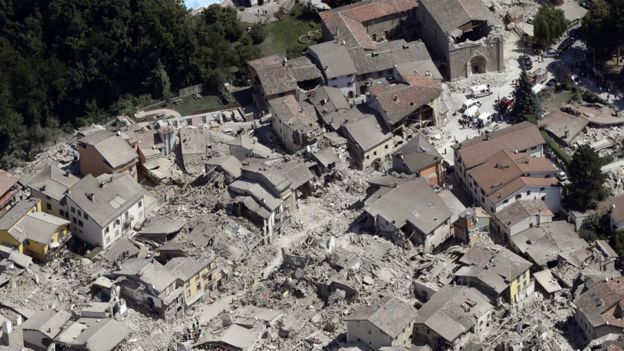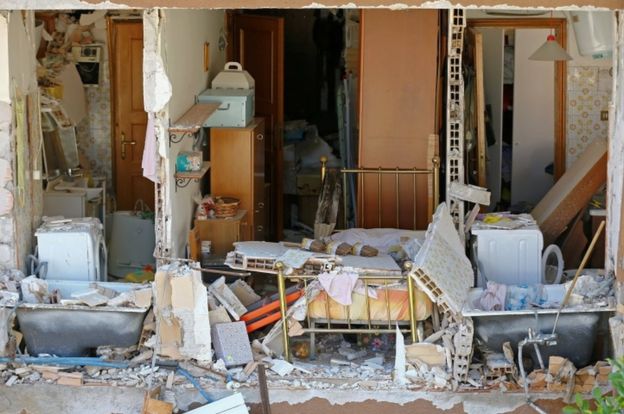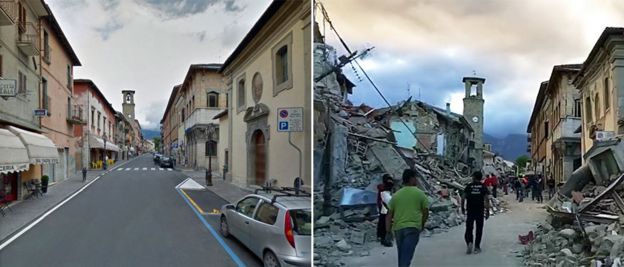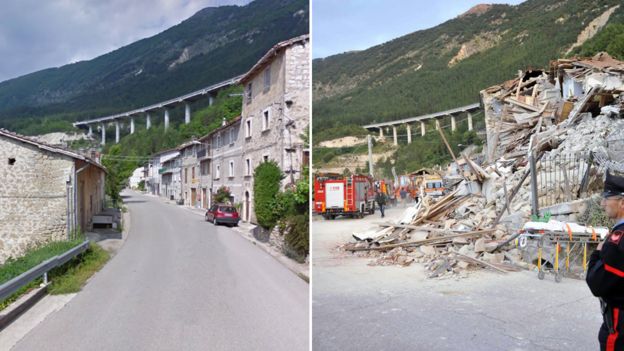The death toll in the Italian earthquake stands at 241 as rescuers continue efforts to find survivors.
Dozens of people are believed trapped in ruined Amatrice, Accumoli and Pescara del Tronto, in mountainous central Italy.
There have been hundreds of aftershocks since the quake struck, hampering relief efforts and damaging already unstable buildings.
More than 4,300 rescuers are using heavy machinery and their bare hands.
Rescuers have advised journalists and bystanders to leave Amatrice urgently, as “the town is crumbling”, the BBC’s Jenny Hill says.
Another powerful aftershock struck the town on Thursday afternoon, sending a huge dust cloud into the air
Many of the earthquake’s victims were children, the health minister said, and there were warnings the toll could rise further.
The heaviest death toll was in Amatrice – 184, officials said. Another 46 died in Arquata, and 11 in Accumoli. A further 264 people have been treated in hospital.
Officials revised down the number of dead after earlier giving a figure of 247.
Media captionDrone shows extent of Italy quake destruction
The 6.2-magnitude quake hit at 03:36 (01:36 GMT) on Wednesday 100km (65 miles) north-east of Rome.
“We are sleeping in the car and there were shocks all night. When the biggest one came, the car started moving and shaking,” said Monica, a survivor from Amatrice.
At the scene: BBC’s Damian Grammaticas in Pescara del Tronto
Two firemen burrowed deep into the rubble looking for a survivor. “It’s a dog,” one of them shouted out.
For half an hour the men kept digging. They passed water down to be given to the animal. And eventually they worked it free, then emerged, carrying it to the surface. There was a ripple of congratulations through the crowd.
“It doesn’t matter to us if it’s a person or an animal, we save it,” said Gianni Macerata, the fire officer in charge.
So the digging goes on. But so little is left of Pescara del Tronto it is unlikely that more survivors will be found here.
It seems unlikely too that this ancient little place, that has stood for centuries, can ever be rebuilt. Hundreds of years of history ended in an instant.
A tented camp has been set up, as so many buildings are now unsafe.
Prime Minister Matteo Renzi was chairing an emergency cabinet meeting on Thursday. The agenda included reconstruction plans for the devastated area.
 Image copyrightAP
Image copyrightAP Image copyrightREUTERS
Image copyrightREUTERSRescuers said they had pulled five bodies from the ruins of the Hotel Roma in Amatrice. As many as 70 tourists were staying at the hotel when the quake struck. Many are feared to be in the rubble, though several were pulled out and given medical care.
Many of those affected were Italians on holiday in the region. Some were in Amatrice for a festival to celebrate a famous local speciality – amatriciana bacon and tomato sauce.
Late on Wednesday there were cheers in the village of Pescara del Tronto when a young girl was pulled alive from the rubble after being trapped for 17 hours. Almost all the houses there had collapsed, the mayor said.
Among the victims was an 18-month-old toddler, Marisol Piermarini, whose mother Martina Turco survived the deadly 2009 earthquake in L’Aquila and moved away from there after the experience, Italian news agency Ansa reported.
Ms Turco was being treated in hospital after being pulled from the rubble in the village of Arquata del Tronto, Ansa said.
The mayor of Amatrice said three-quarters of the town had been destroyed and no building was safe for habitation.
The country is no stranger to earthquakes: the 2009 L’Aquila tremor killed more than 300 people and in May 2012 two tremors nine days apart killed more than 20 people in the northern Emilia Romagna region.
Why is Italy at risk of earthquakes? By Jonathan Amos
Earthquakes are an ever-present danger for those who live along the Apennine mountain range in Italy.
Through the centuries thousands have died as a result of tremors equal to, or not much bigger than, the event that struck in the early hours of Wednesday. The modern response, thankfully, has been more robust building and better preparation.

Mediterranean seismicity is driven by the great collision between the African and Eurasian tectonic plates; but when it comes down to the specifics of this latest quake, the details are far more complicated.
The Tyrrhenian Basin, or Sea, which lies to the west of Italy, between the mainland and Sardinia/Corsica, is slowly opening up.
Scientists say this is contributing to extension, or “pull-apart”, along the Apennines. This stress is compounded by movement in the east, in the Adriatic.
The result is a major fault system that runs the length of the mountain range with a series of smaller faults that fan off to the sides. The foundations of cities like Perugia and L’Aquila stand on top of it all.
 Image copyrightGOOGLE/AP
Image copyrightGOOGLE/AP Image copyrightGOOGLE/EPA
Image copyrightGOOGLE/EPA




